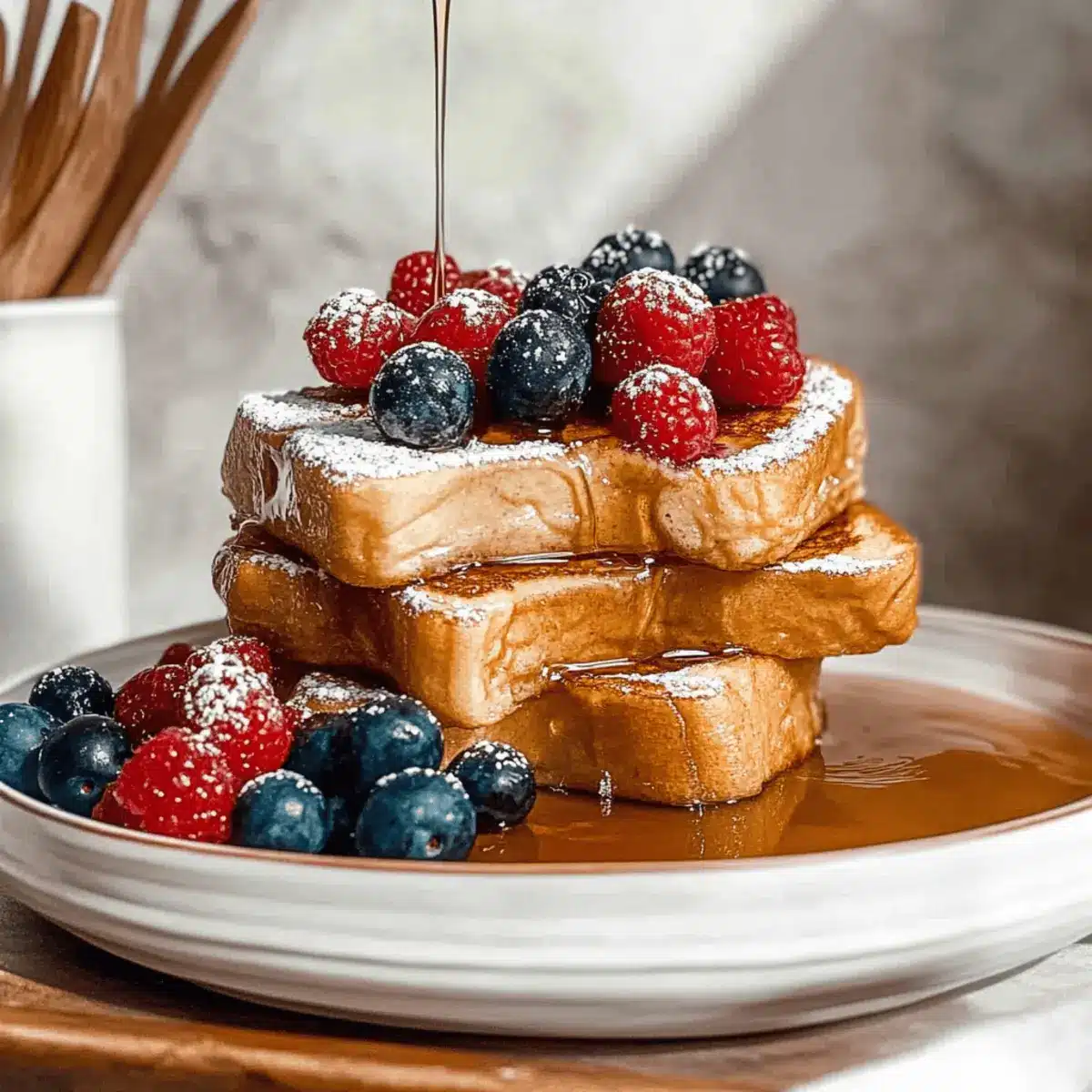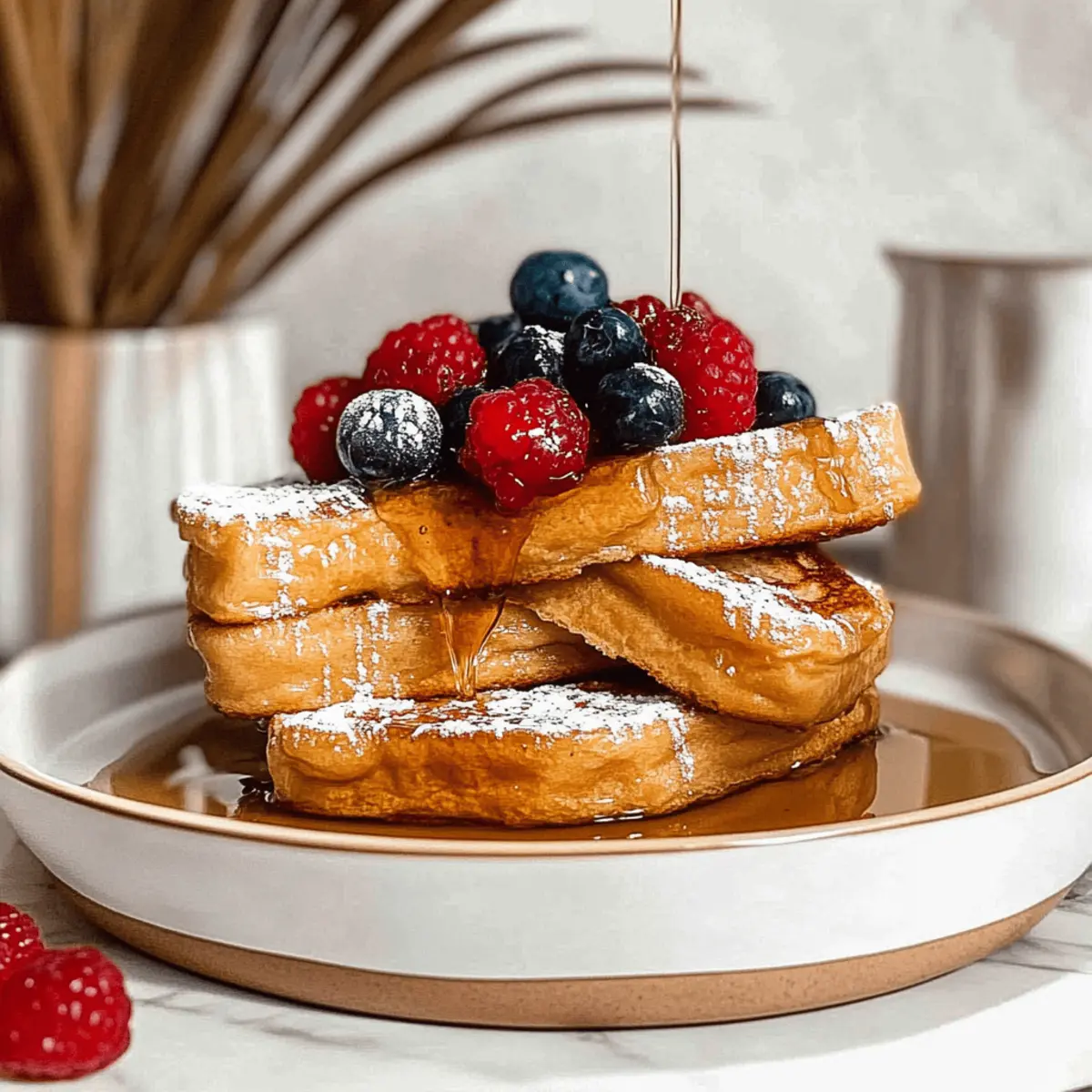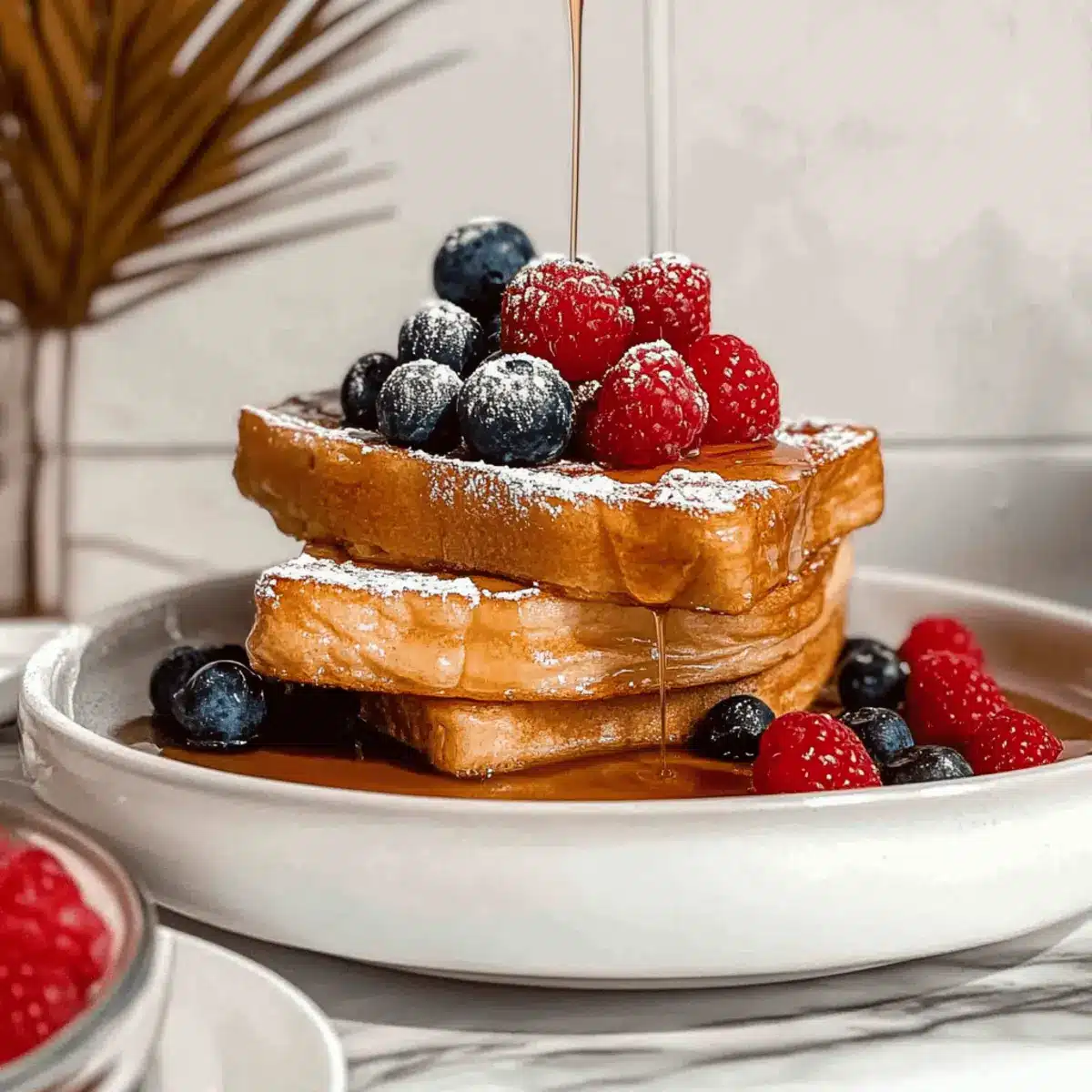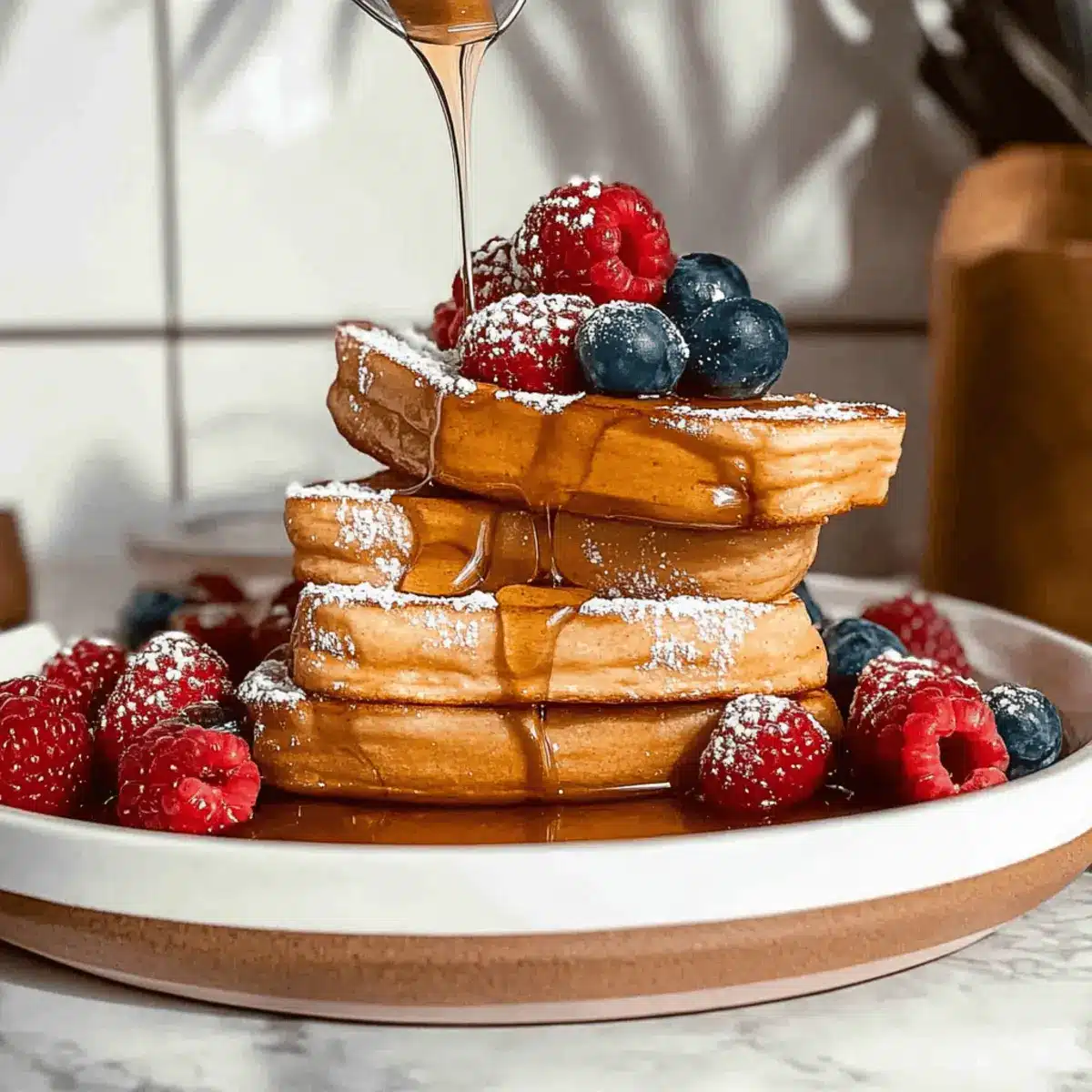A delicious morning ritual awaits as the sun peeks through the kitchen window, casting a warm glow on your favorite pan. This Easy Dairy-Free French Toast (Without Milk) is the perfect solution for anyone craving a cozy breakfast without the heaviness of dairy. With quick preparation and easy-to-find ingredients, it’s a delightful way to cherish lazy Sunday mornings or impress family on weekday breakfasts. The crispy, golden-brown exterior gives way to a soft, tender bite, making it an instant crowd-pleaser that even those who aren’t avoiding dairy will love. Plus, it’s versatile enough for gluten-free enthusiasts! Are you ready to transform your breakfast game with this simple yet satisfying recipe?

Why choose dairy-free French toast?
Simplicity at Its Best: The recipe requires minimal ingredients and just a few easy steps, making it perfect for busy mornings.
Crowd-Pleasing Flavor: The combination of warm cinnamon and rich vanilla creates an irresistible aroma that delights everyone.
Adaptable for All Diets: Whether you’re gluten-free or looking for dairy alternatives, there are variations to suit your needs, like using gluten-free bread or plant-based milk.
Quick Preparation: With just a few minutes to prep and cook, this breakfast can be ready before you know it!
Perfect for Any Occasion: Serve it on a lazy Sunday brunch or make it a weekday treat; it’s sure to satisfy any palate.
Fresh Toppings: Serve with your favorite toppings—think maple syrup, fresh fruits, or even a dusting of powdered sugar for extra sweetness!
French Toast Ingredients
• Here’s everything you need for delicious French Toast (Without Milk)!
For the Batter
- Thick Slices of White Bread or Challah – Provides structure and optimal absorption; using slightly stale bread elevates the texture.
- Eggs – Acts as the binding agent, creating richness; swap for flax eggs for a vegan version.
- Water – Dilutes the egg mixture for a smooth consistency; replacing it with dairy-free milk adds extra flavor.
- Neutral Tasting Oil (e.g., canola) – Ensures moisture and prevents sticking during cooking; consider coconut oil for a deliciously tropical twist.
- Vanilla Extract – Enhances flavor profile; opt for pure vanilla for a deeper, authentic taste.
- Cinnamon (¼ teaspoon) – Infuses warmth and spice; adjust based on your personal preference for sweetness.
- Brown Sugar (1 teaspoon, optional) – Sweetens the mix; can be omitted if using inherently sweet bread but delightful in moderation.
- Oil for Frying – Helps with browning and prevents sticking; keep your frying pan well greased for the best results!
Enjoy whipping up this fabulous Dairy-Free French Toast that everyone will love!
Step‑by‑Step Instructions for French Toast (Without Milk)
Step 1: Whisk the Batter
In a shallow bowl, combine 2 large eggs, ½ cup of water, 1 teaspoon of vanilla extract, and 1 tablespoon of neutral oil. Whisk the mixture vigorously until frothy and fully combined, creating a smooth batter that will coat the bread. This easy step sets the base for your delicious Dairy-Free French Toast, so ensure it’s well blended and ready to go!
Step 2: Add Flavor
Stir in ¼ teaspoon of cinnamon and, if desired, 1 teaspoon of brown sugar to the egg mixture. Mix until the cinnamon is evenly distributed and the sugar dissolves. This fragrant blend will coat the bread, adding warmth and sweetness to your French toast experience. Make sure to achieve an even, aromatic mixture before moving on to the next step.
Step 3: Preheat Your Skillet
Place a non-stick skillet or griddle over medium heat and allow it to warm for about 3-4 minutes. You can test if it’s ready by flicking a little water onto the surface; it should sizzle and evaporate immediately. This preheating is crucial for achieving that perfect golden-brown crust on your French toast slices.
Step 4: Soak the Bread
Take your thick slices of white bread or challah and dip each slice into the egg batter. Ensure to coat both sides evenly, but don’t soak them for too long; a quick dip of about 5 seconds per side works best to prevent sogginess. You want each slice to absorb enough mixture without falling apart!
Step 5: Fry the Toast
Once the skillet is hot, add a small amount of oil to cover the base. Gently place the soaked bread slices onto the skillet, ensuring there’s enough space between each for even cooking. Fry for 2-3 minutes on each side until they turn a beautiful golden brown and develop a crispy exterior. Adjust the heat as necessary to avoid burning.
Step 6: Finish and Serve
Carefully transfer the cooked French toast to a plate and repeat the soaking and frying process with the remaining slices. Once all your Dairy-Free French Toast is done, serve them immediately while they’re warm and crispy. Top with your favorite additions like maple syrup, fresh berries, or a dusting of powdered sugar, and enjoy a delightful breakfast!

Expert Tips for Dairy-Free French Toast
• Choose Stale Bread: Using slightly stale bread prevents sogginess, allowing it to soak without falling apart. Thicker slices like challah work best!
• Monitor Heat Carefully: Cooking at an even medium heat is key to achieving that perfect golden-brown crust. Adjust the temperature as needed during frying.
• Avoid Over-Soaking: Dip bread into the egg mixture for just 5 seconds per side to maintain structure. Over-soaking can lead to mushy French toast.
• Experiment with Flavors: Feel free to add a pinch of nutmeg or other spices to the batter for a unique twist. It elevates the flavor while keeping the recipe simple.
• Serve Immediately: For optimal taste and texture, serve your Dairy-Free French Toast hot from the skillet. It’s at its best when warm and crispy!
Make Ahead Options
These Dairy-Free French Toast slices are perfect for meal prep, allowing you to enjoy a cozy breakfast with minimal morning fuss. You can prepare the egg mixture up to 24 hours in advance; simply whisk together the eggs, water, vanilla extract, and oil, then refrigerate it in an airtight container. Additionally, you can slice the bread ahead of time—just store it in a zip-top bag to keep it from drying out. When you’re ready to cook, dip the bread slices into the prepared mixture and fry them as usual. This make-ahead strategy saves time without sacrificing flavor, ensuring your French toast is just as delicious!
What to Serve with Easy Dairy-Free French Toast
Savor the morning as you create a symphony of flavors and textures around your delightful French toast experience.
-
Crispy Bacon: The savory, salty crunch of crispy bacon pairs effortlessly with the sweet, fluffy French toast, making every bite a balance of indulgence.
-
Fresh Berries: Juicy strawberries, blueberries, or raspberries brighten the plate, adding a burst of freshness that complements the cinnamon and vanilla beautifully.
-
Maple Syrup: A drizzle of pure maple syrup enhances the toast’s warmth, providing a natural sweetness that’s simply irresistible.
-
Coconut Whipped Cream: For a touch of decadence, top your French toast with creamy coconut whipped cream, creating a tropical twist that’s both airy and rich.
-
Yogurt Parfait: Serve with a yogurt parfait layered with granola and fruits to introduce both creaminess and crunch, elevating your breakfast delight.
-
Nut Butter: Smooth almond or hazelnut butter spread adds a depth of flavor and creaminess that contrasts wonderfully with the crispy exterior of the French toast.
-
Chilled Juices: Refresh with a glass of freshly squeezed orange juice or a berry smoothie, bringing a zesty brightness that complements the richness of your meal.
-
Homemade Cinnamon Sugar: A sprinkle of cinnamon sugar creates an extra layer of flavor that enhances each bite, transforming your breakfast into a sweet treat.
French Toast (Without Milk) Variations
Feel free to customize this delightful recipe to suit your taste buds and dietary needs!
- Gluten-Free: Substitute gluten-free bread to enjoy a delicious alternative that everyone can savor.
- Vegan Option: Replace eggs with flax eggs (1 tablespoon flaxseed meal + 2.5 tablespoons water) for a plant-based twist.
- Nut Milk Boost: Swap water for almond or oat milk to infuse a creamy flavor without dairy.
- Spice It Up: Add a pinch of nutmeg or cardamom for an aromatic depth that complements the vanilla and cinnamon.
- Sweetness Alternatives: Use maple syrup or honey in place of brown sugar to add a luscious sweetness to your batter.
- Tropical Vibe: Incorporate coconut milk instead of water and use coconut oil for frying to create a tropical-inspired French toast.
- Whipped Coconut Cream: Top off your French toast with whipped coconut cream and fresh fruit for an indulgent, dairy-free treat.
- Savory Twist: Try seasoning the batter with herbs like basil or thyme for a unique savory French toast that pairs well with eggs or avocado.
Don’t forget to check out our ideas for delicious French Onion Beef Sloppy Joes or other breakfast dishes that bring warmth and comfort to your table!
How to Store and Freeze French Toast (Without Milk)
Fridge: Keep any leftover French toast in an airtight container in the fridge for up to 3 days. Reheat in a toaster or skillet for a crispy texture.
Freezer: Wrap individual slices tightly in plastic wrap and store in a freezer-safe bag for up to 2 months. Thaw overnight in the fridge before reheating.
Reheating: To enjoy your French toast, preheat your skillet or a toaster. Heat each slice for 2-3 minutes on medium until warmed through and slightly crispy.
Make-Ahead Tip: For convenience, prepare the egg mixture ahead of time and refrigerate for up to 1 day; soak the bread just before cooking for the freshest taste!

Dairy-Free French Toast Recipe FAQs
What type of bread is best for dairy-free French toast?
Thick slices of white bread or challah are ideal as they provide structure and allow for optimal absorption of the egg mixture. Using slightly stale bread helps prevent sogginess, making for a fluffier French toast.
How should I store leftover French toast?
Keep any leftover dairy-free French toast in an airtight container in the refrigerator for up to 3 days. For a crispy texture upon reheating, use a toaster or skillet, heating each slice for about 2-3 minutes.
Can I freeze dairy-free French toast?
Absolutely! To freeze, wrap individual slices tightly in plastic wrap and store them in a freezer-safe bag. They can be kept in the freezer for up to 2 months. When you’re ready to enjoy, thaw overnight in the fridge and reheat on a skillet for the best flavor and texture.
What if my French toast turns out soggy?
If your French toast is soggy, it’s likely due to over-soaking the bread. Make sure to dip the bread in the egg mixture for about 5 seconds per side, ensuring even coverage without excessive soaking. Additionally, using slightly stale or thicker slices of bread can help maintain the right texture.
Are there any dietary considerations for pets or allergies?
Yes! This recipe contains eggs, which are generally safe for most humans but should not be fed to pets. If anyone in your household has an egg allergy, consider substituting with flax eggs made by mixing 1 tablespoon of ground flaxseed with 2.5 tablespoons of water. Always check ingredient labels for other potential allergens based on personal dietary restrictions.
Can I prepare the batter in advance?
Yes! You can prepare the egg mixture ahead of time and store it in the refrigerator for up to 1 day. Just remember to soak the bread just before cooking for the freshest taste and optimal texture.

Dairy-Free French Toast: Enjoy Comfort Food Without Milk
Ingredients
Equipment
Method
- In a shallow bowl, whisk together the eggs, water, vanilla extract, and neutral oil until fully combined and frothy.
- Stir in the cinnamon and optional brown sugar until evenly incorporated.
- Preheat the skillet or griddle over medium heat for 3-4 minutes until hot.
- Quickly dip each slice of bread into the egg batter, making sure both sides are coated without soaking too long.
- Add a small amount of oil to the skillet and place the soaked slices in, frying for 2-3 minutes on each side until golden brown.
- Once cooked, serve immediately with toppings such as maple syrup, fresh berries, or powdered sugar.

Leave a Reply